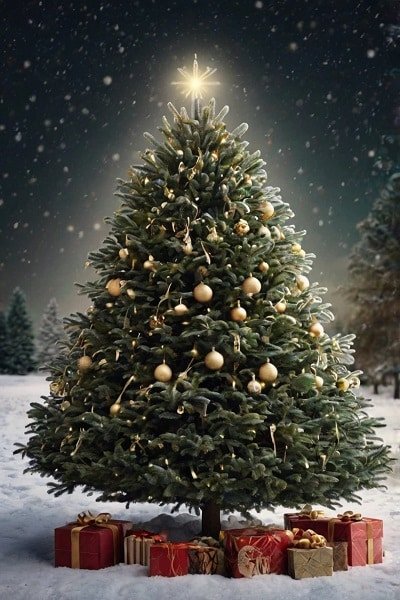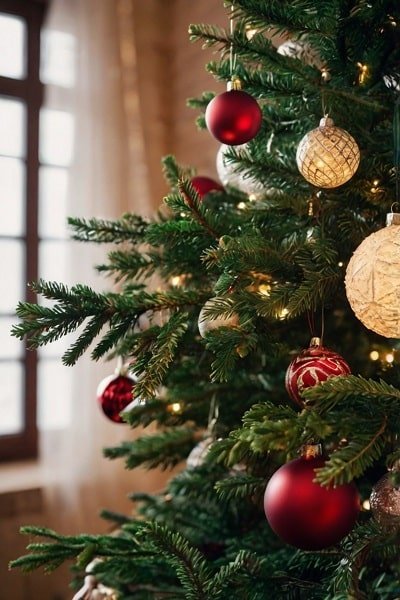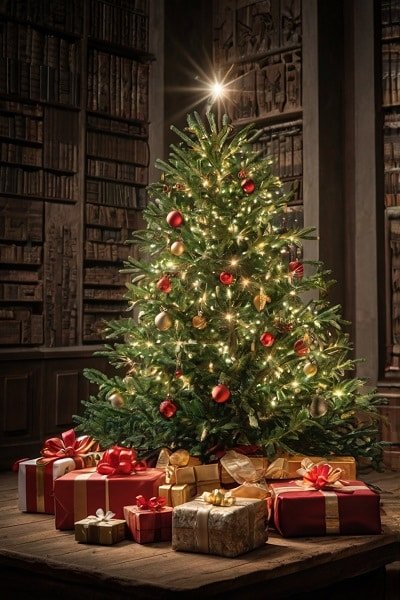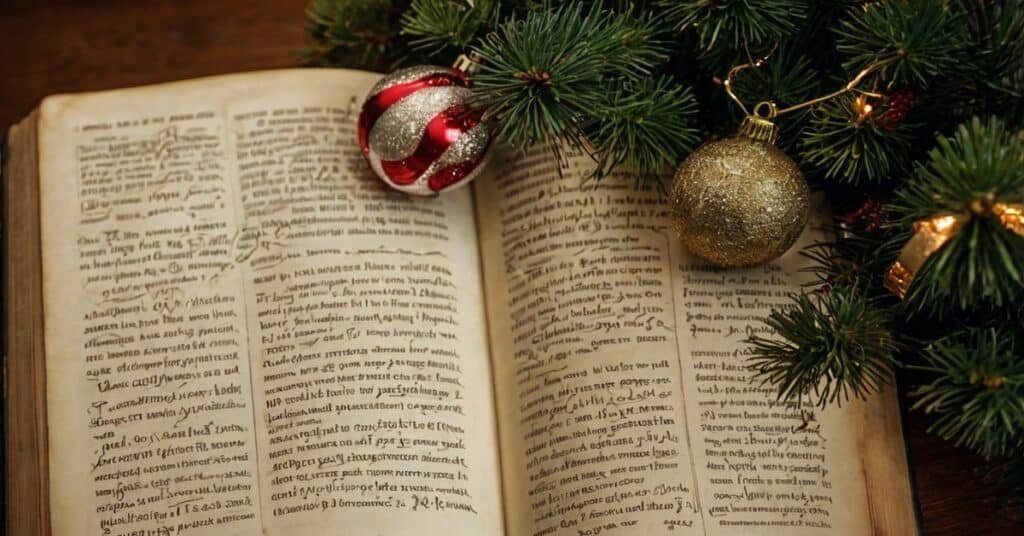Bible verses about Christmas trees spark curiosity and contemplation during the holiday season. Have you ever wondered about the biblical foundation of this beloved tradition? While decorating your tree with twinkling lights and cherished ornaments, you might be surprised to learn what scripture actually says or doesn’t say about this festive symbol.
Join us as we explore the fascinating intersection of faith and tradition, uncovering passages that both supporters and critics reference in their understanding of Christmas trees. Whether you’re seeking spiritual guidance or simply interested in the historical context, this journey through biblical references will enrich your holiday experience and perhaps transform how you view that evergreen standing in your living room.
In this article, we’ll explore 27 Bible verses that connect with various aspects of Christmas trees and their symbolism, helping you appreciate this holiday tradition through a scriptural lens. Whether you’re looking to incorporate more meaning into your Christmas decorations or simply curious about what the Bible says about Christmas trees, these verses offer thoughtful perspectives that bridge faith and tradition.
Trees as Symbols of Life and Growth

1. Genesis 2:9
“And out of the ground the Lord God made to spring up every tree that is pleasant to the sight and good for food. The tree of life was in the midst of the garden, and the tree of the knowledge of good and evil.”
This verse reminds us that God created trees for both beauty and purpose. The original trees in Eden were designed to please the eye and provide sustenance qualities that our Christmas trees reflect in their beauty and the joy they bring. Consider how your Christmas tree might represent God’s creative beauty and provision in your home this season.
2. Psalm 1:3
“He is like a tree planted by streams of water that yields its fruit in its season, and its leaf does not wither. In all that he does, he prospers.”
The evergreen nature of Christmas trees parallels this psalm’s image of unwithering leaves a symbol of constancy and reliability. This verse invites us to reflect on how remaining connected to God (our living water) sustains us through all seasons. As you water your Christmas tree, remember your own need for spiritual nourishment that keeps your faith vibrant and green.
3. Psalm 92:12-14
“The righteous flourish like the palm tree and grow like a cedar in Lebanon. They are planted in the house of the Lord; they flourish in the courts of our God. They still bear fruit in old age; they are ever full of sap and green.”
The cedar trees mentioned here were known for their strength, beauty, and longevity qualities represented in our Christmas evergreens. This passage speaks to the enduring vitality of faith, even as we age. Your Christmas tree can serve as a reminder that spiritual freshness doesn’t diminish with years but can grow stronger when rooted in God’s presence.
4. Isaiah 41:19
“I will put in the wilderness the cedar, the acacia, the myrtle, and the olive. I will set in the desert the cypress, the plane and the pine together.”
This prophetic verse shows God’s power to transform barren places through the gift of trees. Similarly, the Christmas tree transforms ordinary spaces into places of celebration and reflection. During the often busy and sometimes spiritually dry holiday season, allow your Christmas tree to remind you of God’s ability to bring life and beauty into every situation.
5. Isaiah 60:13
“The glory of Lebanon shall come to you, the cypress, the plane, and the pine, to beautify the place of my sanctuary, and I will make the place of my feet glorious.”
Here, trees are connected to worship and God’s presence used to beautify his sanctuary. Your Christmas tree can likewise serve as a focal point for family worship during the holiday season. Consider gathering around your decorated tree for family prayer times that celebrate Christ’s birth and presence in your home.
6. Ezekiel 17:23
“On the mountain height of Israel will I plant it, that it may bear branches and produce fruit and become a noble cedar. And under it will dwell every kind of bird, in the shade of its branches birds of every sort will nest.”
This verse portrays trees as providers of shelter and security. Christmas trees similarly create a gathering place for family and friends. The presents gathered beneath its branches symbolize generosity and provision. As you arrange gifts under your tree, reflect on how your home might offer spiritual shelter and nurture to those who enter it during the holiday season.
Light and Decorations: Biblical Connections

7. Genesis 1:3-4
“And God said, ‘Let there be light,’ and there was light. And God saw that the light was good. And God separated the light from the darkness.”
Light was God’s first creation, highlighting its fundamental importance. The lights adorning Christmas trees echo this primordial creative act. As you string lights on your tree, remember that Jesus came as the Light entering our darkness. Each twinkling bulb can serve as a reminder of God’s good gift of light that dispels both physical and spiritual darkness.
8. Matthew 5:14-16
“You are the light of the world. A city set on a hill cannot be hidden. Nor do people light a lamp and put it under a basket, but on a stand, and it gives light to all in the house. In the same way, let your light shine before others, so that they may see your good works and give glory to your Father who is in heaven.”
Just as Christmas tree lights are prominently displayed to bring warmth and joy, Christians are called to shine brightly in a dark world. The decorated tree in your window can be a wonderful metaphor for how your faith should be visible and attractive to others. Consider how your actions during the Christmas season might reflect Christ’s light to neighbors and visitors.
9. John 8:12
“Again Jesus spoke to them, saying, ‘I am the light of the world. Whoever follows me will not walk in darkness, but will have the light of life.'”
This profound declaration connects directly to the lights on our Christmas trees. Christ, whose birth we celebrate, identifies himself as the ultimate source of illumination for human existence. When you turn on your tree lights each evening, use that moment to remind your family that Jesus came to bring spiritual light and guidance to every aspect of our lives.
10. 1 John 1:5-7
“This is the message we have heard from him and proclaim to you, that God is light, and in him is no darkness at all. If we say we have fellowship with him while we walk in darkness, we lie and do not practice the truth. But if we walk in the light, as he is in the light, we have fellowship with one another, and the blood of Jesus his Son cleanses us from all sin.”
The multiple lights on a Christmas tree can represent the community of believers walking in God’s light together. This passage reminds us that light creates fellowship. As friends and family gather around your illuminated tree, let it inspire conversations about walking in truth and maintaining authentic relationships centered on Christ’s cleansing work.
11. Revelation 22:2
“Through the middle of the street of the city; also, on either side of the river, the tree of life with its twelve kinds of fruit, yielding its fruit each month. The leaves of the tree were for the healing of the nations.”
This apocalyptic vision describes the tree of life bearing different fruits reminiscent of the varied ornaments decorating our Christmas trees. These decorations can symbolize the diverse gifts and blessings God provides. When hanging ornaments, especially those with special memories or significance, reflect on specific ways God has provided “fruit” in your life throughout the year.
Gifts and Giving: Biblical Perspectives

12. Matthew 2:10-11
“When they saw the star, they rejoiced exceedingly with great joy. And going into the house, they saw the child with Mary his mother, and they fell down and worshiped him. Then, opening their treasures, they offered him gifts, gold and frankincense and myrrh.”
The Magi’s gifts to Jesus provide the scriptural foundation for our tradition of Christmas gift-giving. The presents under your tree can serve as reminders of these first Christmas gifts. Consider how each gift you give might represent not just material value but spiritual significance perhaps strength (gold), worship (frankincense), or sacrifice (myrrh).
13. James 1:17
“Every good gift and every perfect gift is from above, coming down from the Father of lights, with whom there is no variation or shadow due to change.”
This verse reminds us that all true gifts originate from God. The presents under your Christmas tree are merely extensions of God’s generosity toward us. When selecting and wrapping gifts, remember that you’re participating in a reflection of God’s giving nature. Take a moment to thank God for being the ultimate gift-giver who provides what we truly need.
14. 2 Corinthians 9:7
“Each one must give as he has decided in his heart, not reluctantly or under compulsion, for God loves a cheerful giver.”
Christmas often involves significant gift-giving, and this verse addresses our attitude in that process. Rather than approaching holiday shopping as an obligation, we can choose joyful generosity. As you place gifts under your tree, examine your heart are you giving cheerfully? Consider scaling back if needed to ensure your giving comes from genuine joy rather than pressure.
15. John 3:16
“For God so loved the world, that he gave his only Son, that whoever believes in him should not perish but have eternal life.”
This most famous verse highlights the ultimate Christmas gift Jesus himself. All other gifts pale in comparison to God’s gift of salvation. Your Christmas tree and the presents beneath it can serve as visual reminders of this supreme act of divine generosity. Consider placing something symbolic at the top or base of your tree specifically to remind your family of God’s indescribable gift.
16. Romans 6:23
“For the wages of sin is death, but the free gift of God is eternal life in Christ Jesus our Lord.”
The contrast in this verse emphasizes that while we deserved one thing (death), God gave us something entirely different through Christ (life). Similarly, Christmas gifts represent unmerited kindness. When exchanging presents around your tree, use the opportunity to discuss how God’s gift of salvation differs from earned rewards, reinforcing the concept of grace in your family conversations.
Evergreen Nature: Symbols of Eternal Life
17. Isaiah 55:13
“Instead of the thorn shall come up the cypress; instead of the brier shall come up the myrtle; and it shall make a name for the Lord, an everlasting sign that shall not be cut off.”
This prophetic imagery describes transformation thorns becoming beautiful trees and introduces the concept of “an everlasting sign.” Evergreen Christmas trees remain green when other plants appear lifeless, making them powerful symbols of eternal life. Your Christmas tree can remind your family that Christ came to transform our spiritual deadness into everlasting life.
18. Psalm 52:8
“But I am like a green olive tree in the house of God. I trust in the steadfast love of God forever and ever.”
The psalmist compares himself to an ever-flourishing tree, thriving because of his connection to God. Similarly, your Christmas tree stands vibrant and green in your home during winter. Let this imagery remind you that spiritual vitality comes through trusting God’s unfailing love especially during difficult seasons when everything around seems dormant.
19. Isaiah 61:3
“…to grant to those who mourn in Zion to give them a beautiful headdress instead of ashes, the oil of gladness instead of mourning, the garment of praise instead of a faint spirit; that they may be called oaks of righteousness, the planting of the Lord, that he may be glorified.”
This verse describes God’s people as “oaks of righteousness” strong, enduring trees that bring glory to God. The Christmas tree in your home can similarly be a testimony to God’s transformative work. For those experiencing grief during the holidays, the evergreen tree offers a gentle reminder that God exchanges mourning for joy and weakness for strength through Christ’s coming.
20. John 15:4
“Abide in me, and I in you. As the branch cannot bear fruit by itself, unless it abides in the vine, neither can you, unless you abide in me.”
Though referring to vines rather than trees, this verse emphasizes the importance of remaining connected to our source of life. Your Christmas tree, once cut, begins a slow process of drying out a poignant reminder that spiritual life requires ongoing connection to Christ. The water you provide for your tree can symbolize the living water Christ offers that sustains eternal life.
21. Revelation 2:7
“He who has an ear, let him hear what the Spirit says to the churches. To the one who conquers I will grant to eat of the tree of life, which is in the paradise of God.”
This promise points to our ultimate restoration to Eden’s perfection, where access to the tree of life is regained. Your Christmas tree can represent this hope of paradise restored through Christ. Consider adding an ornament or decoration specifically symbolizing the tree of life, reminding your family of the eternal reward awaiting those who remain faithful.
Trees and Nature in Worship
22. Psalm 96:11-12
“Let the heavens be glad, and let the earth rejoice; let the sea roar, and all that fills it; let the field exult, and everything in it! Then shall all the trees of the forest sing for joy.”
This beautiful imagery personifies trees as worshipers singing praises to their Creator. Your Christmas tree can similarly “participate” in your family’s worship during the holiday season. Consider gathering around your tree for times of singing carols or reading Christmas scripture, allowing it to be a focal point for your family’s expression of joy and adoration.
23. Isaiah 44:23
“Sing, O heavens, for the Lord has done it; shout, O depths of the earth; break forth into singing, O mountains, O forest, and every tree in it! For the Lord has redeemed Jacob, and will be glorified in Israel.”
Again, trees are depicted as rejoicing in God’s redemptive work. The Christmas tree tradition can be reframed as creation’s celebration of the Redeemer’s birth. The various decorations might represent different aspects of nature joining the chorus of praise. As you decorate your tree, play worshipful Christmas music that echoes this theme of all creation celebrating Christ’s coming.
24. 1 Chronicles 16:33
“Then shall the trees of the forest sing for joy before the Lord, for he comes to judge the earth.”
This verse portrays nature anticipating and celebrating God’s coming a fitting parallel to the Advent season. Your Christmas tree stands as a representative of creation’s recognition of its Lord. Consider establishing a tradition of reading scripture about Christ’s return while gathered around your decorated tree, connecting his first coming (which we celebrate) with his promised return.
25. Nehemiah 8:15
“And that they should proclaim it and publish it in all their towns and in Jerusalem, ‘Go out to the hills and bring branches of olive, wild olive, myrtle, palm, and other leafy trees to make booths, as it is written.'”
This verse describes the gathering of tree branches for the Feast of Booths a celebration of God’s provision and presence. While different from Christmas trees, it establishes biblical precedent for using elements of nature in celebrations of faith. Your Christmas tree can similarly serve as a temporary sanctuary a special place created to focus on remembering and celebrating God’s presence with us.
26. Luke 21:29-30
“And he told them a parable: ‘Look at the fig tree, and all the trees. As soon as they come out in leaf, you see for yourselves and know that the summer is already near.'”
Jesus used trees as teaching tools, pointing to their natural characteristics to illustrate spiritual truths. The Christmas tree can similarly serve an educational purpose in your home. Consider creating devotional moments around your tree that use its features to teach children biblical principles—perhaps relating the tree’s height to God’s greatness or its branches to our need to remain connected to Christ.
27. Psalm 148:9,13
“Mountains and all hills, fruit trees and all cedars!… Let them praise the name of the Lord, for his name alone is exalted; his majesty is above earth and heaven.”
This psalm includes trees in the universal chorus of praise to God. Your Christmas tree can be reimagined as an expression of this creative worship. Consider how the very presence of the tree in your home adorned and honored might serve as a reminder that all of creation, including the elements we bring indoors, exists ultimately to exalt God’s majesty.
Conclusion
While the Bible doesn’t directly address Christmas trees as we know them today, these 27 verses demonstrate how trees, light, gifts, and natural elements can carry deep spiritual symbolism that enriches our holiday celebrations. Rather than seeing Christmas trees as mere decorations or secular traditions, we can intentionally use them as prompts for reflection on biblical truths and Christ-centered worship.
As you set up and enjoy your Christmas tree this season, consider how its presence in your home might direct your family’s thoughts toward the eternal life Christ offers, the light he brings into our darkness, and the generous gift of himself given for our salvation. These scriptural connections can transform a simple holiday tradition into a meaningful spiritual practice.
Remember that God often uses tangible, visible elements to help us grasp spiritual realities. Just as communion bread represents Christ’s body and baptismal waters signify cleansing from sin, your Christmas tree can serve as a beautiful, sensory reminder of God’s everlasting love, presence, and provision during this special season of celebration and reflection.
Bonus: Practical Ways to Use These Verses with Your Christmas Tree
- Scripture Ornaments: Create or purchase ornaments featuring these Bible verses. Hang a different verse on the tree each day of Advent as a countdown to Christmas.
- Daily Devotionals: Select one verse to read and discuss each evening when you light your tree. Create simple questions for family members of all ages.
- Tree Dedication Service: When you first set up your tree, gather your family for a special tree dedication using several of these verses, similar to a church service opening, to establish its spiritual significance in your home.
- Verse-Themed Decorations: Choose one or two verses that particularly resonate with your family and let them inspire your tree’s decorative theme. For example, the “light of the world” verses might inspire a tree with abundant lights.
- Scripture Reading Rotation: Assign each family member one of these verses to memorize and recite during a special Christmas Eve gathering around the tree.
- Prayer Moments: Use your tree as a gathering place for family prayer times, with these verses serving as prompts for specific thanksgiving and requests.
- Verse Gift Tags: Write one of the gift-themed verses on gift tags to connect the presents under your tree with their deeper spiritual significance.
- Tree-Centered Bible Study: Host a special Bible study gathering in your home, using your Christmas tree as a visual aid while exploring these verses together.
- Protection Prayers: Use verses that speak to God’s protection and provision to pray protective prayers over your home during the Christmas season.
- Thank You Notes: Include tree-themed verses in thank you cards sent after Christmas, explaining how the gift reminded you of God’s generosity.
- Morning Reflections: Begin your day with morning devotions near your Christmas tree, using one verse as a meditation focus.
- Scripture Art Display: Create artistic renderings of key verses to display near your tree, or use them as alternative tree toppers with spiritual significance.
Frequently Asked Questions
Does the Bible prohibit Christmas trees?
No, the Bible does not prohibit Christmas trees. The passage in Jeremiah 10:1-5 that some interpret as condemning Christmas trees actually refers to ancient idolatry practices where people would cut down trees, carve them into idols, decorate them with silver and gold, and then worship them. Modern Christmas trees are not objects of worship but decorative symbols that can remind us of biblical truths. The intention behind the tradition matters when used as a celebration of Christ’s birth rather than as an idol, Christmas trees can be meaningful additions to Christian holiday observances.
Are Christmas trees mentioned in the Bible?
Christmas trees as we know them today are not specifically mentioned in the Bible, as the tradition developed much later in history (primarily in 16th-century Germany). However, trees, their symbolism, and their use in celebrations are mentioned throughout Scripture. The Bible includes numerous references to trees as symbols of life, growth, and God’s provision, as well as the use of tree branches in various celebrations like the Feast of Booths (Nehemiah 8:15).
What is the spiritual significance of decorating a Christmas tree?
Decorating a Christmas tree can carry multiple spiritual meanings. Lights can represent Christ as the light of the world (John 8:12) and believers reflecting that light (Matthew 5:14-16). Ornaments can symbolize the fruits of the Spirit (Galatians 5:22-23) or the diverse gifts God gives His people. The star or angel topper commemorates either the Star of Bethlehem that guided the Magi or the angelic announcements of Christ’s birth. The evergreen nature of the tree itself can represent eternal life offered through Christ. When approached mindfully, each decorative element can reinforce aspects of the Christmas story and biblical teaching.
How can I make our family Christmas tree more Christ-centered?
To create a more Christ-centered Christmas tree experience, consider incorporating special ornaments that tell the nativity story, adding scripture ornaments featuring key Christmas Bible verses, establishing family devotional times around the tree, or creating meaningful traditions like sharing testimonies of God’s faithfulness from the past year while decorating. You might also replace some commercial decorations with symbols of faith and create a special tree-lighting ceremony that includes prayer and worship. For men leading their families, this can be a meaningful way to establish spiritual leadership during the holidays.
What does the star on top of the Christmas tree represent biblically?
The star topper represents the Star of Bethlehem described in Matthew 2:1-12, which guided the wise men to find the infant Jesus. Biblically, this star was a divine sign that led these Gentile scholars to worship the newborn King. On your Christmas tree, the star can serve as a reminder that God provides guidance to those seeking Christ and that Jesus came for all nations and peoples. It can also represent the declaration of Christ’s birth that extends beyond Jerusalem to the broader world, inviting everyone to come and worship.
Can Christmas trees be used for family devotions?
Absolutely! Christmas trees make excellent focal points for family devotions during the holiday season. You might read a different Christmas-related Bible passage each evening with the tree lights providing the only illumination. Consider creating an Advent calendar with daily scriptures and small activities that relate to your tree. You could also establish a tradition where family members share how they’ve experienced God’s presence or blessing before hanging a special ornament. These family prayer times around the tree can create lasting spiritual memories.
What can evergreen trees teach us about our faith?
Evergreen trees remain vibrant and green even in the harshest winter conditions, making them powerful metaphors for spiritual constancy. They can teach us about remaining faithful during difficult seasons (Psalm 1:3), the eternal life Christ offers that transcends natural decay (John 3:16), and the importance of spiritual vitality that doesn’t diminish with circumstances (Jeremiah 17:8). Their year-round foliage reminds us that God’s love and promises remain unchanging regardless of external conditions or seasons of life.
How can I explain the symbolism of Christmas trees to children?
For children, concrete visual examples work best. Explain how the evergreen nature reminds us that God’s love never dies or fades away. The lights show how Jesus brings light into a dark world, and how we should shine for others. Ornaments can represent the different “fruits” or good things that grow in our lives when we love Jesus. The gifts under the tree help us remember God’s gift of Jesus and the gifts the wise men brought. Consider creating a special ornament craft activity where children make decorations representing different Bible verses or aspects of the Christmas story.
Is having a Christmas tree a pagan practice?
While some elements of Christmas tree traditions have historical connections to pre-Christian European winter celebrations, the Christmas tree as we know it today was adopted and adapted by Christians who infused it with new, Christ-centered meaning. This pattern of redeeming cultural practices by infusing them with gospel significance has biblical precedent; for example, Paul quoted pagan poets and used Greek philosophical concepts to communicate truth (Acts 17:28). The key consideration is how the tradition functions in your celebration today as a Christ-honoring symbol or as something that distracts from the true meaning of Christmas.
What does the Bible say about decorating for Christmas in general?
The Bible doesn’t directly address Christmas decorations since the holiday as we celebrate it developed centuries after Scripture was written. However, biblical principles can guide our approach to decorating. Scripture affirms beauty and celebration in worship (Exodus 28:2, 40), remembrance through visual symbols (Joshua 4:4-7), and the appropriate use of creation to honor God (Psalm 96:11-12). Balanced against these are warnings against materialism (Luke 12:15) and keeping our focus on Christ rather than external trappings. Decorations that remind us of Christ’s birth and inspire worship align with biblical principles.
Can Christmas trees be used in church services?
Many churches incorporate Christmas trees into their sanctuary decorations during Advent and Christmas. When thoughtfully presented, these trees can enhance worship by providing visual reinforcement of the season’s themes. Churches might use them as “Chrismon trees” decorated solely with Christ-centered symbols, as backgrounds for nativity scenes, or as focal points for special services like candle lighting ceremonies. Just as Solomon adorned the temple with natural imagery including trees (1 Kings 6:29), modern churches can thoughtfully incorporate these symbols in ways that direct attention to Christ rather than distract from worship.

Noah James is the author behind PrayersLand, a blog dedicated to inspiring faith, hope, and spiritual growth. With a deep passion for prayer and devotion, he shares heartfelt reflections, powerful prayers, and uplifting insights to strengthen believers on their spiritual journey. His writings aim to bring comfort, wisdom, and divine connection.

